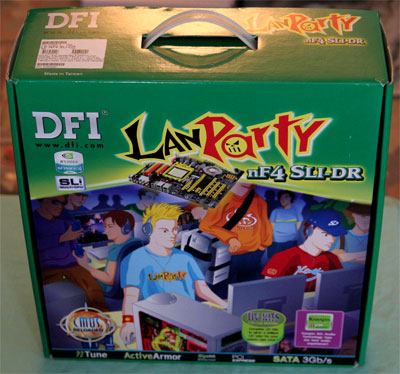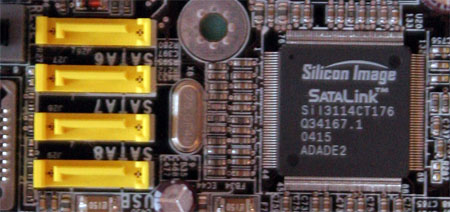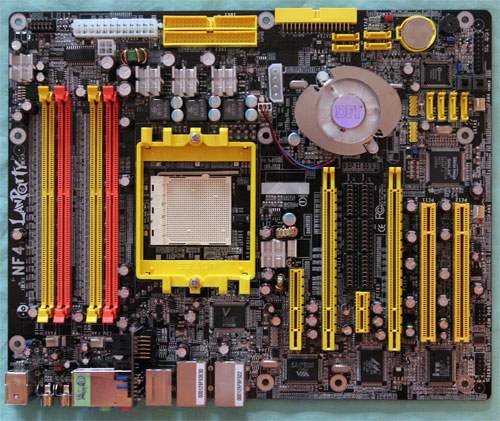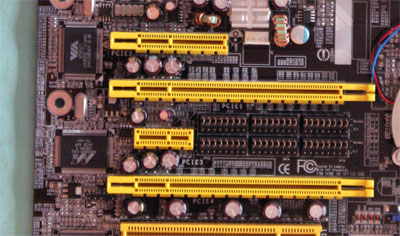nForce4 SLI Roundup: Painful and Rewarding
by Wesley Fink on February 28, 2005 7:00 AM EST- Posted in
- Motherboards
DFI LANParty nF4 SLI-DR: Features and Layout
| Specification | DFI LANParty nF4 SLI-DR |
| CPU Interface | Socket 939 Athlon 64 |
| Chipset | nForce4 SLI (single chip) |
| BUS Speeds | 200MHz to 456MHz (in 1MHz increments) |
| PCI/AGP Speeds | Asynchronous (Fixed) |
| PCI Speeds | 100MHz to 145MHz in 1MHz increments |
| Core Voltage | Auto, 0.8V to 1.55V in 0.025V increments (Normal) PLUS *104%, 110%, 113%, 123%, 126%, 133%, 136% (Special - to 1.85V) |
| CPU Startup Voltage | Startup, 0.825V to 1.550V in 0.025V increments |
| DRAM Voltage | 2.5V to 3.2V in 0.1V increments (3V jumper) 2.5V to 4.0V in 0.1V increments (5V jumper) |
| Chipset Voltage | 1.5V, 1.6V, 1.7V, 1.8V |
| Hyper Transport Ratios | Auto, 1.0, 1.5, 2.0, 2.5, 3.0, 4.0, 5.0 |
| LDT Bus Transfer | 16/16, 16/8, 8/16, 8/8 |
| LDT Voltage | 1.2V, 1.3V, 1..4V, 1.5V |
| CPU Ratios | Auto, 4x to 25x in 0.5x increments |
| Cool'n'Quiet MAX FID | Auto, 8.0 to 13.0 in 0.5x increments |
| DRAM Speeds | Auto, 100, 120, 133, 140, 150, 166, 180, 200 |
| Memory Command Rate | Auto, 1T, 2T |
| Memory Slots | Four 184-pin DDR Dual-Channel Slots Unbuffered ECC or non-ECC Memory to 4GB Total |
| Expansion Slots | 2 x16 PCIe Slots 1 x4 PCIe 1 x1 PCIe 2 PCI Slots |
| SLI Setup | Six 16-pin Jumper Blocks |
| Onboard SATA | 4-Drive SATA 2 by nF4 PLUS 4-Drive SATA by Sil3114 |
| Onboard IDE | Two Standard nVidia ATA133/100/66 (4 drives) |
| SATA/IDE RAID | 4-Drive SATA 2 PLUS 4-Drive IDE (8 total) Can be combined in RAID 0, 1 PLUS 4-Drive SATA by Sil3114 Sil3114 Raid 0, 1, 5 |
| Onboard USB 2.0/IEEE-1394 | 10 USB 2.0 ports supported nF4 2 1394A FireWire ports by VIA VT6307 |
| Onboard LAN | Dual Gigabit Ethernet PCIe by Vitesse VSC8201 PHY PCI by Marvel 88E8001 |
| Onboard Audio | Karajan Audio Module based on Realtek ALC850 8-Channel codec with 6 UAJ audio jacks, CD-in, front audio, and coaxial SPDIF In and Out |
| Other Features | Power and Reset momentary switches |
| BIOS | Award 2/17/2005 Release |
The DFI boards all support the full range of nVidia nForce4 features including nVRAID, Active Armor, SATAII 3Gb/s drives, NCQ, any-drive IDE/SATA Raid, PCIe Gigabit LAN by a PHY Ethernet chip (plus an additional PCI Gigabit LAN), and the nTune utility.
Packaging for the full LANParty nF4 SLI-DR is typical LANParty.

DFI has continued with the Karajan Audio Module first introduced on their LANParty 925x. As you will see later in our audio tests, the Karajan module was a much better performer than what we expected when we first saw the onboard Realtek 850 codec. We still wish that DFI had been able to use the High Definition ALC880 or a similar chip instead of the more common ALC850. However, the Karajan Module on the DFI SLI does provide the lowest CPU overhead that we have seen on any board using the 850.
The ALC850 Codec provides four pairs of stereo outputs, with 5-Bit volume controls and multiple stereo and mono inputs, along with flexible mixing, and gain and mute functions. Two 50mW/20ohm headset audio amplifiers are integrated at Front-Out and Surround-Out, and both amplifiers are selectable for Front-Out, Line-In and Mic-In as a Universal Audio Jack.
You can find more information on the ALC850 at Realtek.
DFI provides a full selection of rear I/O ports. These include 6 programmable audio mini jacks plus coaxial SPDIF in and out connectors to support the Realtek ALC850. The back panel also includes PS2 mouse and keyboard, 1 standard Firewire (IEEE1394a), 6 USB, and two RJ45 Gigabit Ethernet. There are no rear ports for a Parallel Printer or serial devices, but there is an onboard header for an external serial device an IR header.

The four DIMM slots support up to 4GB of up to DDR400 memory in a Dual-Channel memory configuration. Dual-Channel 1 is DIMMs 1 and 3, and Dual-Channel 2 is DIMMs 2 and 4. DFI specifies support for both ECC and non-ECC unbuffered memory. Contacts at DFI advise that best overclocking is achieved with the dual-channel DIMMs in Sockets 2 and 4.
Board Layout
The DFI LANParty nF4 SLI-DR is very well arranged, with almost everything located where it works best. As you will see if you study the layouts of the other SLI boards, the DFI differs substantially in layout.The DFI nF4 place the CPU in the top center of the board and DIMMs at the top. This arrangement worked well in our testing and should work better (for those who change memory frequently) than in the crowded right-hand alternate location used on many boards.

There is plenty of room around the Socket 939, so most Heat sink/Fans should work fine. A Zalman 7000 overhung DIMM slot 4, but it still cleared our stock OCZ memory and memory could work in all slots.
The IDE connectors are at our preferred upper right edge of the motherboard, and the floppy connector is a board edge connector located on the right edge around the middle of the board. Both locations worked well in our testing.


Asus A8N-SLI Deluxe: Overclocking and Stress Testing
DFI LANParty nF4 SLI-DR: Overclocking and Stress Testing










108 Comments
View All Comments
Gholam - Monday, February 28, 2005 - link
I'm curious, where can I find benchmarks of SiI3114 with a 3 or 4 drive RAID5 setup? Read/write speed, access time, CPU utilization (especially important since it's essentially a software hack), general stability impressions, etc.I'm finally replacing my aging Duron 1200 soon, and looking at A8N-SLI Deluxe (no other NF4 board has a layout suitable for passive/quiet chipset cooling due to video card interference), and I plan to eventually build a ~700GB redundant storage array as home media server on it. However, I can't find benchmarks of SiI3114 RAID5 function anywhere.
Slaimus - Monday, February 28, 2005 - link
About the audio CPU utilization tests. Is that with the nForce Audio or Realtek driver?Wesley Fink - Monday, February 28, 2005 - link
#15,#18 and others - the 3DMark2003 SLI scores were an incorrect duplicate of 3DMark05. The 3DMark03 SLI scores have now been corrected and should make sense now. I apologize for the error.#4 - I saw none of the heat and instability issues with the DFI that were described at [H]. I discussed this with Editors from several other websites who also had no problems with this board. I would agree that the 5V jumper for very high memory voltages can get everything on the board real hot real fast, but this is a feature unique to the DFI and one that only the hardcore with more advanced cooling would attempt to use anyway.
#5,#20 - Any x16 PCIe slot can be used for x1 or x4 or any other flavor of PCIe. MSI does NOT have an extra x1 slot, but they tell us video slot 2 can be used for an x1 device. You still can't use SLI and another PCIe device at the same time on the MSI, but you can use single video with an additional PCIe device in video slot 2.
Wesley Fink - Monday, February 28, 2005 - link
#4 - Abit has just shipped the Fatal1ty Ultra board to AnandTech. We haven't even received it yet. It will be included in a later Ultra roundup, bu the Ultra boards will have the same performance in single video as the similar SLI board from the same manufacturer. We met with Abit this weekend and they told us it would still be several weeks until their SLI would be available for review - and the SLI is NOT a Fatal!ty board.L3p3rM355i4h - Monday, February 28, 2005 - link
318fsb 1:1? Jeezus Christ!ChineseDemocracyGNR - Monday, February 28, 2005 - link
"but on the Asus board you also have to connect another 4-pin Molex for additional video card power. Asus says that this is required for "stable SLI operation", but the other 3 SLI designs do fine and are quite stable without the 5th power connector."The gold-winner DFI also has the same connector, though it wasn't mentioned in the review. And even though it wasn't necessary in your testings (with an OCZ 520W PSU), other people (like tbreak.com) could only find a stable SLI setup with the ASUS board, probably because of it.
I also don't think its location is important, the fact it's close to the PCI-E x16 slots is probably a smart engineering decision.
For future reviews it would be nice if you could show results with "Maximum FSB" where it actually means "Maximum FSB", that is, you remove memory overclocking from the table. It's great to see DDR600 and beyond, but I'm the kind of guy who spends $130 for quality 1GB of RAM, but still want a board that can take a 3000+ to 9*300.
It's not really a 1:1 ratio as you're always using a divider for memory speeds (from the CPU clock).
Looking forward to reviews of the mainstream PCI-E boards (K8T890, nF4 Ultra, etc).
ceefka - Monday, February 28, 2005 - link
oops typoIt's a shame that there are non nF4 Ultra boards with HD Audio.
I meant
It's a shame that there are none nF4 Ultra boards with HD Audio.
ceefka - Monday, February 28, 2005 - link
Jeez, Wesley, that must have been a hell of a job. Thanx.It's a shame that there are non nF4 Ultra boards with HD Audio.
#12 Right, I am contemplating the Gigabyte GA-K8NXP-9 (the Ultra, not the SLI) and wonder if the Yesico FL-420ATX will do. Have you searched http://www.msi.com.tw/program/products/mainboard/m... or http://www.giga-byte.com/MotherBoard/Products/Prod... ? Look for manuals (Gigabyte) and compatability tables (MSI).
I wish though these manufacturers would clearly state if its ATX 1.3 or 2.0 etc + minimum V/A requirements. That would be much easier than scrolling through their website.
Just one silly question, because this has not been clear since the introduction of SLI-boards. Can you use a one of the 16xPCI-e slots on a SLI-board for something else than a second graphics card (in the future)? Maybe a (hefty) soundcard in the future?
neologan - Monday, February 28, 2005 - link
btw, excellent review, one of the best i've read in a long time!blckgrffn - Monday, February 28, 2005 - link
Yeah, what is with the 3dmark03 scores? The SLI seems really low..more like a repeat of the 05 scores....Glad to see more indepth mobo reviews! I for one was getting tired of looking at the BIOS as a way to differentiate!